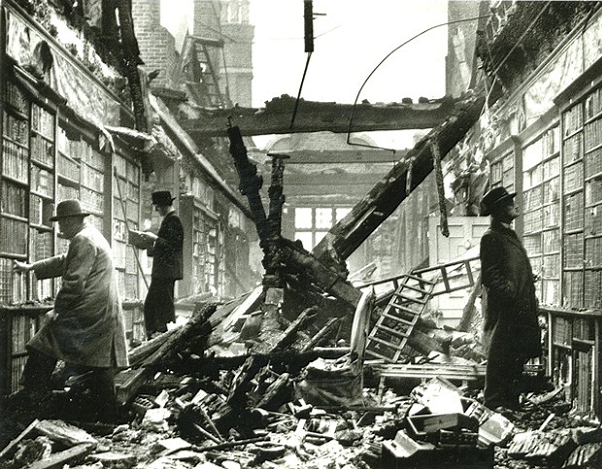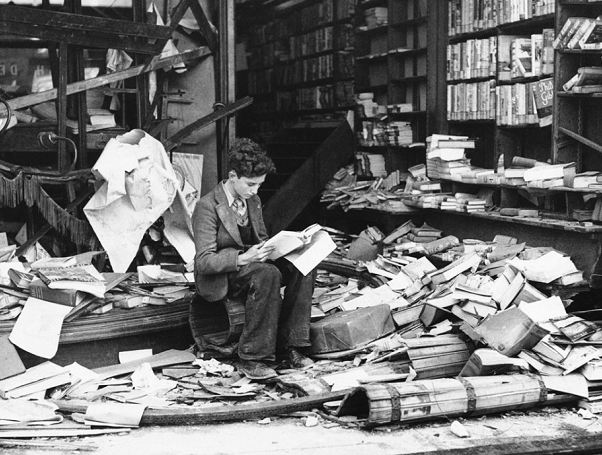[ by Charles Cameron — a bookish Brit myself, I could easily see myself in either one of these pictures ]
.
One trouble with my DoubleQuotes format is that it conforms any images or texts to its own size: there are times when a larger font size in text — or a larger version of an image, allowing greater detail to be seen — would be preferable, as in the case of these two photos from the Blitz:
and:
**
The first has been nicely described by Eileen A. Joy in her book-in-progress, Postcard from the Volcano: Beowulf, Memory, History:
Consider the well-known photograph taken of Holland House in London of September 1940, the morning after a German air raid had devastated the house, but had somehow left the library walls, with their shelves of neatly arranged books, mostly intact. This was the period of the Blitz, when the German Luftwaffe bombed London and other English cities continuously for months, hoping to make Britain vulnerable to a land invasion. Holland House, the remnants of which now form part of an open-air theater, was built in 1605 for Sir Walter Cope. It was one of the first "great houses" of Kensington, and during England’s Civil War it was occupied by Cromwell’s army.The photograph shows three men in bowler hats who appear quite comfortable, even calm, as they browse and select books from the tidy stacks, while all around them lie the bombed-out ruins of the house, its roof smashed to pieces, its charred beams exposed, ladders and chairs and other assorted pieces of furniture crushed under the rubble. But the browsers appear oblivious to the terrors of the night before and the chaos surrounding them on all sides. They are the very image of scholarly repose, of quiet study and reflective contemplation, and the symmetry of the books and shelves are the very picture of order in the midst of disorder. Outside, but also inside, lies a world on the brink of apocalypse, what Churchill called "the abyss of a new dark age" (Winston S. Churchill, The Second World War: Their Finest Hour [Boston, 1949], 2: 225-26).
The photograph provides an image of the fetishization of the text, or document, of the ways in which history attaches itself, not to the social disturbances and crises surrounding it on all sides, but to the ruins of the past, and even more so, to the orderly archive of the narratives of those ruins. In that austere repository of the bound volumes of fabula and historia — the library — the scholar seeks the world of lived human experience but encounters instead one of its chief symptoms — writing.
The second is one Zen just used as the header for his most recent Recommended Readings. The Atlanti, which appears to have done the requisite research, titles this image:
A boy sits amid the ruins of a London bookshop following an air raid on October 8, 1940, reading a book titled “The History of London.”
**
So, question:
Is it the love of books we see illustrated in these two photos — or British aplomb?




